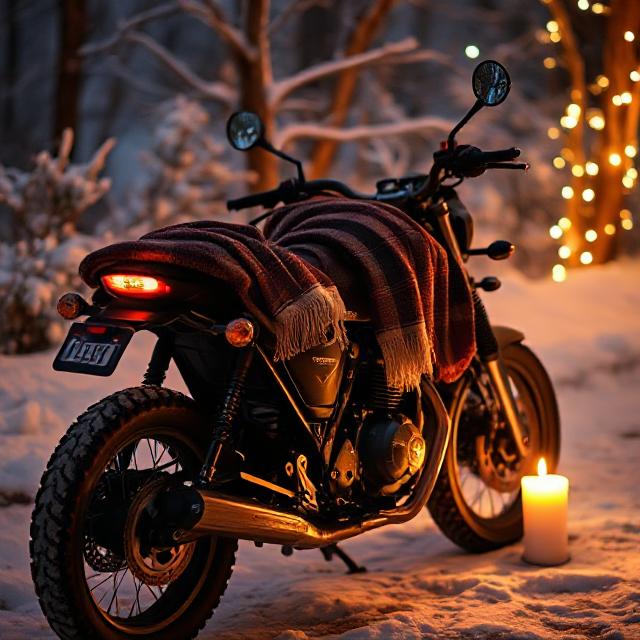How to winterise your motorcycle

Smart tips for a quick and smooth spring start
As autumn turns into winter, it’s time to think about how to look after your motorcycle during the cold season (unless you ride all year round). Proper winter storage doesn’t just keep your bike in good condition – it saves you time, money and frustration when the spring sunshine invites you out for that first ride. Here are some tips on the best ways to care for your bike over the winter months, and the different storage options available.
1. Storage at a dealer or workshop
Many motorcycle dealers and workshops offer winter storage as a complete package. This can include trickle-charging the battery, secure storage (often with locks and alarms), and sometimes basic servicing. Some workshops also carry out an initial inspection to spot any issues and offer repairs during the winter.
Downside? You rarely have access to your bike while it’s stored.
Tip: Ask different dealers and workshops what’s included in their winter storage and at what price. Some offer discounts on labour if you book additional services at the same time. It’s a great opportunity to book a service, tyre change or similar during the off-season. That way you avoid the spring rush at workshops and will be ready to ride from day one. It’s also the perfect time to sort out insurance repairs or upgrade your kit.
Workshops appreciate customers who plan ahead. This helps them spread the workload over the winter and avoid bottlenecks at the start of the season. It benefits them financially – and saves you long waiting times.
2. Shared garage – moderate access
Another option is private garages with space for several bikes. They usually have set opening hours, which allows you to check on your bike, charge the battery or carry out minor maintenance – depending on what the landlord allows.
Tip: Search motorcycle forums or social media groups to find a garage nearby. Make a plan for the winter and schedule a few sessions in your calendar for small jobs – ideally with a deadline by the end of February. This way you’ll have time to sort out unexpected repairs if anything crops up. Also make a note of the tasks you can’t do yourself and book a slot at a workshop.
3. Your own garage – freedom with responsibility
If you store your motorcycle at home, you have full access – perfect for those who like doing their own maintenance. With this freedom comes the responsibility of making sure the bike is safe and ready for the new season.
Tip: Make a checklist!
- 🔧 Go over your bike carefully: Check the condition of the tyres, fork seals, brake fluid and drive chain/sprockets. Note what you can do yourself, order parts, and book a workshop appointment for the things you can’t fix on your own.
- 🧥 Check your gear: Don’t forget that your motorcycle clothing also needs some care during the winter. Small holes or tears in leather and textile can often be repaired by yourself.
- 🪡 On All about Bikes you’ll find the mini-tip article Repair, save, ride on – sewing motorcycle clothing , where we show you how to extend the life of your gear yourself.
Is there anything that needs washing or sending to the cleaners? Waterproof garments, such as Gore-Tex, lose their effectiveness if they are dirty, and they can’t be washed just any way – they require extra heat treatment to maintain their waterproofing properties.
Also take the opportunity to inspect your helmet. Is it approaching five years old? That’s the recommended maximum age for motorcycle helmets to ensure the best possible safety. Autumn sales or a Black Friday promotion can be an excellent opportunity to pick up a bargain!
A few extra important details
Wash your motorcycle before putting it away for the season. Dirt traps moisture, which can cause rust damage to fork legs, the chain, bolts – in fact, anything made of metal. Make sure to dry the bike thoroughly, ideally with compressed air, once it has been washed. Lubricate the chain when you’re finished. You can also run the engine for a short while; the heat generated helps to dry the surrounding parts.
When a motorcycle stands unused for a long time, the battery needs exercise. Use the correct charger for your motorcycle’s battery. Lithium batteries and lead–acid batteries require different types of chargers due to their different properties.
If the bike is stored in an unheated garage, the coolant must be frost-resistant. A glycol mix withstands sub-zero temperatures, whereas plain water or non-frost-protected coolant risks freezing and causing the system to crack. Also make sure that the tyres are not exposed to extreme cold, and ideally use paddock stands or an insulating surface for the bike to rest on.
Don’t forget the lock! It’s not uncommon for insurance companies to require two locking devices, even if the motorcycle is stored in a locked garage (requirements may differ depending on whether it is kept at your home address or somewhere else). This can be solved, for example, with a steering lock combined with a disc lock or a fixed chain and shackle. Always check with your insurer what applies in your case.
Before the first spring ride – carry out a final safety check
When the time finally comes to roll out the bike, do a quick but thorough inspection:
- Check that nothing is loose. Are all bolts, footpegs, controls, nuts and screws tightened?
- If you’ve changed brake pads, pump the brake lever until you build up pressure – you don’t want to set off without being able to stop.
- Are there any leaks?
- Are the tyres in good condition and inflated to the correct pressure?
If you’ve looked after the bike properly during winter storage, there should be nothing more to worry about – then it’s just a matter of firing it up and heading out!
Final words on winter motorcycle storage
Good winter storage is not just about parking the bike and leaving it. This is the period when you prepare for a trouble-free start to the season, use your time proactively and take care of details that could otherwise cause problems. By following the advice in this article – whether you choose professional storage, a shared garage, or your own at home – you can be confident that your bike will be ready from day one, as soon as the sun once again warms the tarmac.

